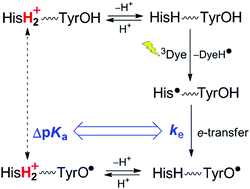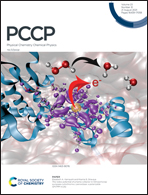Kinetic evidence for the transiently shifted acidity constant of histidine linked to paramagnetic tyrosine probed by intramolecular electron transfer in oxidized peptides†
Abstract
The kinetics of electron transfer (ET) from tyrosine (Tyr) to short-lived histidine (His) radicals in peptides of different structures was monitored using time-resolved chemically induced dynamic nuclear polarization (CIDNP) to follow the reduction of the His radicals using NMR detection of the diamagnetic hyperpolarized reaction products. In aqueous solution over a wide pH range, His radicals were generated in situ in the photo-induced reaction with the photosensitizer, 3,3′,4,4′-tetracarboxy benzophenone. Model simulations of the CIDNP kinetics provided pH-dependent rate constants of intra- and intermolecular ET, and the pH dependencies of the reaction under study were interpreted in terms of protonation states of the reactants and the product, His with either protonated or neutral imidazole. In some cases, an increase of pKa of imidazole in the presence of the short-lived radical center at a nearby Tyr residue was revealed. Interpretation of the obtained pH dependencies made is possible to quantify the degree of paramagnetic shift of the acidity constant of the imidazole of the His residue in the peptides with a Tyr residue in its paramagnetic state, and to correlate this degree with the intramolecular ET rate constant – a higher intramolecular ET rate constant corresponded to a greater acidity constant shift.

- This article is part of the themed collection: 2021 PCCP HOT Articles


 Please wait while we load your content...
Please wait while we load your content...